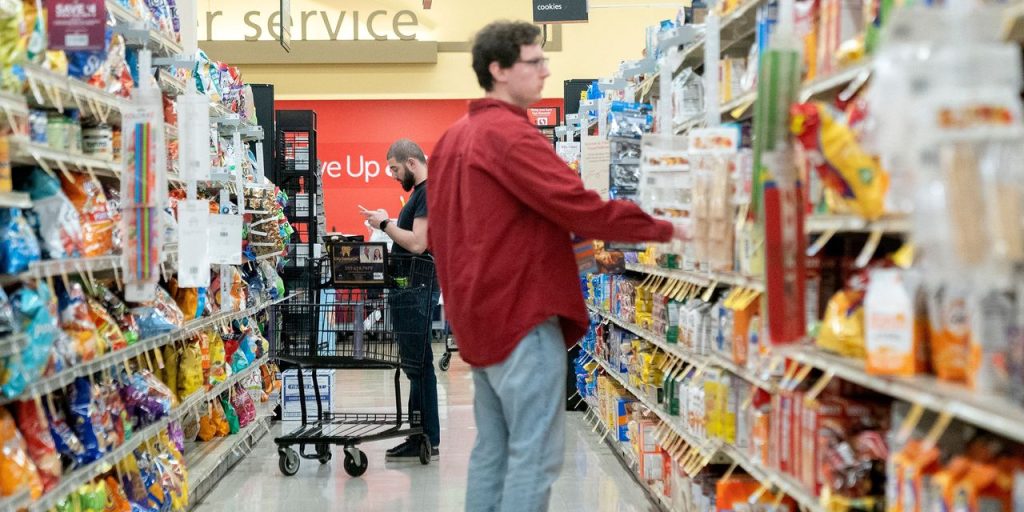Inflation data for March will offer the clearest signal yet as to whether the Federal Reserve will raise interest rates in May for a tenth consecutive time in this cycle. The key to decoding the latest consumer-price-index report, due Wednesday: Look beyond the headline numbers.
Economists expect inflation rose 0.3% in March to reach a 5.2% annual pace. That would mark a sizable deceleration from the 6% annual rate notched in February. But while a slowdown of that magnitude would look like progress, much of it will be due to a decline in energy-services prices as the cost of natural gas falls from year-ago levels, when oil prices were soaring as a result of Russia’s invasion of Ukraine.
While falling energy prices might help Americans at the gas pump, it isn’t what the Fed will care the most about in the March inflation report. The central bank will be focused more on the so-called core consumer price index, a measure that strips out the volatile food and energy categories and is considered a more reliable indicator of where underlying inflation is heading.
And there, consensus expectations are less rosy. Economists forecast core CPI rose 0.4% in March, compared with 0.5% in February, and reached a 5.6% annual pace—up from 5.5% the month before.
The CPI report will be one of the last major data releases before the Fed’s policymaking arm meets again in early May and will have an outsize influence on what bank officials decide to do next. A resoundingly positive jobs report for April has already heightened expectations that the Federal Open Market Committee will vote in favor of another quarter-percentage-point interest-rate hike, rather than pause its monetary-policy tightening to let the cumulative impact of this cycle’s rate hikes trickle through the economy.
If inflation comes in hot as well, as consensus forecasts suggest, that will all but seal the probability of a rate hike in May.
“Persistently strong inflation prints, including a 0.5% [month-over-month] increase in March core CPI, are the key factor in our expectation for continued rate hikes from the Fed,”
Citi
economist Veronica Clark wrote.
One of the primary reasons inflation has been so strong in recent months is due to the high cost of rent, a trend that likely continued in March, as well. Many private-sector measures of rent show that for new leases, price growth has already slowed significantly. But rent inflation as measured by the CPI covers all leases, instead of just new ones—and the slowdown has yet to show up in the government’s official data.
Fed officials have said since last fall that they expect a deceleration in rent prices to show up in the government’s data in the coming months. But given that it hasn’t been evident so far, some economists have begun to raise concerns that the shelter-inflation slowdown might not ever fully materialize the way the central bank expected, in part due to persistent strength in other parts of the economy, which is keeping prices high. That makes shelter costs a key area to watch in the March report.
“The real issue is, does the labor market stay buoyant enough to support rents at higher levels?” says Diane Swonk, chief economist with KPMG. “The Fed is worried about too high of a floor being hit in that area….It’s something to watch.”
Because of the known lag in shelter inflation and the expected slowdown on the horizon, the Fed has been focusing more recently on “supercore” services, or services categories excluding energy and housing.
The supercore services category can be the hardest to tamp down, given that it isn’t nearly as sensitive to rising interest rates as other sectors, such as goods. Any slowdown from recent trend for that category could help support the case at the Fed for a pause at its next meeting.
There is little expectation that March will provide good news on that front, however. Citi economists see physician services bouncing up again after a slowdown in February, for example, while recreation and personal services are both also likely to stay high.
One other category in the spotlight in March: car prices. A spike in the cost of used cars as the economy reopened in 2021 was an initial driver of the current bout of inflation, but car prices as measured by the CPI have been falling for roughly a year. That has helped goods prices overall to decline in recent months, something that has been seen as a win for the Fed even as services prices climb.
But some economists are warning that car prices are on the rise again, which could reverse the recent progress on goods costs overall. Wholesale vehicle prices have been rising since the start of the year and are now beginning to affect retail prices, says Skanda Armanath, a former New York Fed analyst who is now the executive director of Employ America.
Armanath warns that as vehicle prices rise, the cost of vehicle services—such as renting, leasing or insuring a car—tends to rise as well. And the Fed, he adds, appears to be “behind the curve” on the issue.
Because of the way car prices are trending, “you’ve got a little bit of a tailwind on goods inflation that was absent in recent months coming back,” Swonk says. “It further complicates things when…the places you are betting on cooling are reflating even temporarily.”
March inflation data will be released Wednesday at 8:30 a.m.
Write to Megan Cassella at megan.cassella@dowjones.com
Read the full article here



